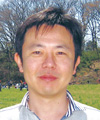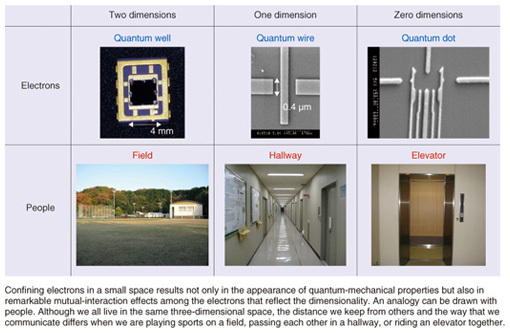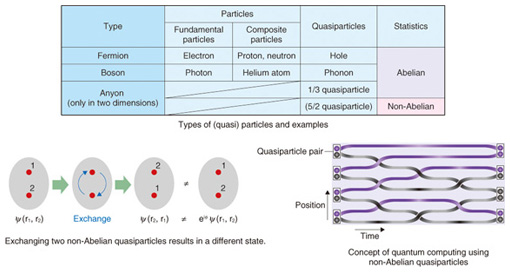 |
|||||
|
|
|||||
|
Front-line Researchers Vol. 10, No. 10, pp. 5–9, Oct. 2012. https://doi.org/10.53829/ntr201210fr1  Basic Research is an Adventure! Pouring Intellectual, Physical, and Technological Power into Unexplored WorldsThe research of Senior Research Scientist Koji Muraki is revolutionary to the point of requiring physics textbooks to be rewritten. The paper written by Dr. Muraki and his colleagues on the 5/2 state supporting the existence of non-Abelian quasiparticles, which are different from the fundamental particles in the natural world, was published in the magazine Science in 2012 to much acclaim. We asked Dr. Muraki to explain to us in layman's terms the results of this research and to tell us how he approaches the research process. Making the most of past experience to manage an entire sequence of processes—Dr. Muraki, please tell us about your current research efforts. In short, my colleagues and I are trying to combine heterostructures, which have artificially formed layers of different types of semiconductors, with finely processed nanostructures. Our goal is to obtain new properties not found in conventional semiconductors and new functions using those properties. To this end, it is important to exploit the quantum-mechanical features of electrons and make use of electron spin (rotational motion) in addition to electron charge (center-of-mass motion). We are paying particular attention to the effects that arise when many electrons behave cooperatively—as they do in superconductors—in contrast to those obtained with non-interacting electrons moving independently. This kind of research requires high-purity semiconductor wafers having minimal effects from impurities, and to meet this need, we are researching ways of making ideal semiconductor wafers having absolutely no noise and no impurity effects. —I can see that explaining cutting-edge technology is difficult. Could you give us a more concrete description? We are fabricating semiconductors having structures and functions different from anything in the past. To fabricate a semiconductor device, one first needs materials, so our work begins with their preparation. The first step here is crystal growth in which we deposit atoms in an orderly fashion on top of a semiconductor substrate (wafer). Then, after processing this deposit into patterns for making a device, we apply current and measure the resulting voltage at temperatures near absolute zero. This sequence of processes is typical of the work we’re involved in. It is difficult to firmly say when research of this type began, but a number of people began to pursue this research in the 1970s, and some of that work led to Nobel prizes. Since then, many people have become involved, and within this research having such a long history, I would say that our group’s work is, in a sense, very advanced. The topic that we are currently focused on is mutual interaction between electrons (Fig. 1). It was Professor Leo Esaki, a Nobel Prize winner, who first proposed that quantum-mechanical properties appear when an electron is confined to a small space inside an artificially tailored semiconductor heterostructure. By quantum-mechanical properties, we mean that an electron can be likened to a wave. It was therefore thought that, if a single electron is behaving like a wave, it should be possible to obtain new properties and functions in a semiconductor. The focus of this research has since expanded to mutual interaction among many electrons, which leads to physical phenomena that cannot occur with only one electron.
—What exactly are non-Abelian quasiparticles? This might be difficult to explain, but to begin with, let’s consider two electrons. Since one electron is identical to another, if these electrons exchange positions, the result is a state that is indistinguishable from the original one. On the other hand, in the case of non-Abelian quasiparticles discussed in the paper in Science [1], if two of these particles exchange positions, the result is a state that is different from the original one (Fig. 2). We wondered whether this property could be useful.
This is one example of the many-body effects that occur when many electrons are present. It does not appear in a crystal that is not of high purity. This is because two electrons interact with each other via the charge that each possesses. In terms of everyday phenomena, static electricity is an example of a buildup of charge, and two negatively charged objects repel each other. A semiconductor generally contains a high number of impurities, and since impurities also have charge, a mixture of such charges together with the electron charges that we are researching would prevent us from observing any mutual-interaction effects intrinsic to electrons. To observe such effects, we must begin by removing impurities to raise the crystal’s purity. That is, we must create an environment in which electrons are completely unhindered by other matter. This kind of research requires a group of researchers having a variety of specialties who can work together toward a common goal. They include specialists at growing crystals, fabricating devices, making measurements, and theoretical analysis. With this approach, however, it may be difficult to appropriately connect the results obtained by each team of specialists. Since I have had experience with a variety of processes throughout my career, whenever a problem has arisen within a team, I have been able to interconnect the results of different processes and obtain an overall picture of the situation to solve the problem. In the system that I described, when special electron states appear in an environment with no impurities at temperatures near absolute zero, we have been able to directly measure the rotational motion of an electron called spin and determine the state of each electron’s spin. In this way, we clarified that spin orientation was the same for all the electrons in question. The states that we are researching are related to a phenomenon called the fractional quantum Hall effect explained by Professor Robert Laughlin, who received the 1998 Nobel Prize in Physics for his work, but they are beyond the conventional understanding based on his theory, so our research results are attracting attention. A researcher needs many options and skills at negotiating with other people.—Looking back at the hardships you have so far encountered, which was the most difficult? Perhaps this is the same with all research, but I was not able to obtain notable results as quickly as I would have liked, which means being largely ignored for a long time. I entered NTT in 1994 and it took two years before I was able to pursue the work that I truly wanted to do. And it wasn’t until 2001—my eighth year with the company—that I was able to present a noteworthy paper, which was published in Physical Review Letters [2]. Thinking that people throughout the world were perhaps reading my paper and approving of the findings that I presented gave me a great sense of accomplishment. At the same time, I was keenly aware that obtaining the recognition that I sought for my work was not going to be easy. Then, about five years later in 2006, I began to be asked to give invited talks. Now, with the publication of our paper in Science, I feel that my work has truly been recognized at long last. My journey to this point has been long indeed. Following the publication of my 2001 paper, I entered a period in which I was worried about how I was going to move up to a higher level as a researcher. I was fortunate in being given the opportunity to do research in Germany at the Max Planck Institute for a relatively long period in the group headed by Professor Klaus von Klitzing (a recipient of the Nobel Prize in Physics), but even at that time, since I was like a stranger thrown into an unfamiliar environment, it was a struggle to persuade the people around me to help me pursue the work that I wanted to do. But looking back at my first two years at NTT, though I was assigned to a post that I had wanted, I lacked the confidence to pursue even the work that I desired. This period in which I was not able to take the first step in my research journey was, in retrospect, the most difficult. I now think, however, that my experiences during these difficult times have actually been beneficial to me. What I learned was that, as a researcher, I must have many options and must persevere in negotiating with other people to get them to agree with my plan of action. I also learned that I must never waver in facing the problems that lie in front of me—I must think seriously about what is the best direction to take. NTT Basic Research Laboratories, where I am currently working, has established an environment in which researchers can pursue the work they desire with much peripheral support. This holds true for me too, but it’s not the case that you can immediately pursue the research that you desire. If current conditions are such that you cannot pursue research exactly as you like, please keep in mind that there is always a chance of changing things, which means that you must never forget the need for patience. Climbing to the top of a small mountain gives a far and wide view.—So you treat adversity as an ally! Perhaps young researchers who are reading this article find themselves in the same environment. What advice would you give to them? One of my hobbies during my time as a student was to play guitar in a band. As an amateur, I began by imitating the style of professional guitar players, and my aim was to play as much like them as possible. It is normal for a guitar player to pass through this stage and then start writing original songs. This is how professionals come to be. If we now substitute research for guitar playing, what comes to mind is that researchers would like to become professionals and write original songs with only minimal experience from an amateur period. This is because the world of research always demands something new and original. As in music, however, the truth is that it takes a really long time to become able to create an original piece of work as a professional, since basic techniques or technologies must be learned. These days, however, the expansion of the Internet has greatly accelerated the speed at which information can be exchanged compared with that when I entered NTT. I believe that an environment that demands speed will include harried young researchers seeking originality in their research. It is better, however, to think of originality as something separate from speed. To me, originality is not simply something that one would like to express on one’s own. Rather, originality is achieved as a result of pursuing for many years something that one is deeply interested in and then being recognized by others for such efforts with comments like “that person is an original researcher” or “that’s research like his”. Simply speaking, isn’t originality doing something different from others? When a person has a deep interest in something, won’t that interest reflect that person’s background? Even in the case of several researchers working on the same research theme, I believe that their individual viewpoints developed from their respective backgrounds can lead to new directions and discoveries. Furthermore, among very successful researchers, is it not true that the research they pursued in school seldom became their life’s work? I think that a research theme that becomes one’s life’s work is a matter of encounter. No researcher knows when the most important encounter in his or her career will occur. On the other hand, there is no guarantee that a cool theme that one is attracted to at present will continue to be exciting and maintain one’s interest in the future. In fact, it is quite likely that it will not. We can draw an analogy with climbing a mountain. If your dream or major goal is a high mountain, then the problem right in front of your eyes can be thought of as a small mountain. Now, making every effort to reach the peak of that small mountain will give you a far and wide view of your situation while increasing the intellectual and physical power you need to climb the next higher mountain. By pursuing research in this way, I believe that a researcher improves his or her chance of an auspicious encounter. —Dr. Muraki, what does research mean to you? I think of basic research as the work of making a map. This is a map not of an area that is already known but rather of unexplored terrain. Making a map means entering an unknown place, and in this sense, it is truly an adventure. To reach that place requires tools and technology, but having an eye for selecting the right tools and developing the skills for using them correctly are also necessary. Those already known to researchers are like the maps available at bookshops. Having an original map unknown to others is crucial to the success of the adventure. A researcher needs not only knowledge but also technical skills and physical stamina, and of greatest importance, the researcher must have a strong will that is unaffected by daily outcomes. My aim is to pursue work that redraws maps, that opens up paths to previously unknown places. References
Koji MurakiSenior Research Scientist (Distinguished Researcher) and Group Leader of the Quantum Solid State Physics Research Group, NTT Basic Research Laboratories. He received the B.E., M.E., and Ph.D. degrees in applied physics from the University of Tokyo in 1989, 1991, and 1994, respectively. He joined NTT Basic Research Laboratories in 1994. From 2001 to 2002, he was a visiting researcher at the Max Planck Institute for Solid State Research, Stuttgart, Germany. His research interests are focused on many-body effects in low-dimensional semiconductor structures. He is a member of the Physical Society of Japan and the Japan Society of Applied Physics. |
|||||


